There appears to be a bit of a growth spurt happening in the split toe (aka tabi) footwear sub-culture of barefoot shoes these days. Probably the most high profile example is the newly released Topo Athletic running shoes. Other brands include ZEM (who have been doing it for years), B2R, SMAAT, and Freet Footwear. Never mind the fact that the Japanese have been doing this since... like... forever.
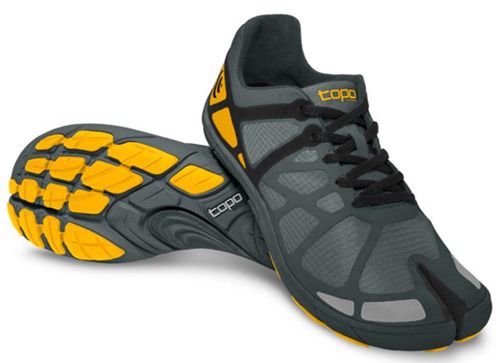
One thing I have noticed when perusing the web and reading reactions is that a lot of people think the whole split toe design is a marketing gimmick - they just don't get it. Another fad trying to get a toe-hold in the footwear market.
This post is my attempt at setting the record straight. I think the split toe design is fabulous. I have been hoping for this for years, and it is finally starting to happen. I think it is almost an inevitable evolution of minimalist footwear. Let's hope that the execution is able to do the technology justice.
The Baseline
Before I get into the benefits of the tabi design, the first thing I want to discuss is the baseline: barefoot. Here at Toe Salad, we come from the perspective that barefoot is the ideal. That's how our bodies were designed. We all should spend substantial amounts of time barefoot to keep our feet and bodies strong and healthy.
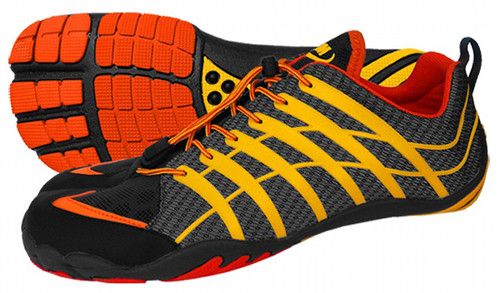
Footwear is a tool. It should be designed to compliment our bare feet, allowing them to to operate in a natural, unhindered fashion. There are many footwear design elements that can affect our feet: things like cushion, drop, arch, flexibility, breathability, etc. In this particular article we are going to focus on the toebox, since that is where all the action is happening in a tabi design.
With bare feet, our toes can splay out any way they need in order to provide us stability, grip, and shock absorption. If our ideal is that a shoe should not hinder natural foot function, then one of the goals of shoe designers should be to design a toebox that allows our toes to splay.
Toebox design
The tabi design attempts to solve the toebox problem by splitting the big toe off from the rest of them into it's own compartment. The idea here is that since the big toe generally wants to splay in the opposite direction from the others, why not let it do that on it's own. This design shares elements of many other toebox designs. A blend that, in my mind, brings together some of the best parts of each. What follows is a brief description of the various toebox designs and how they compare or contrast to that of the tabi.
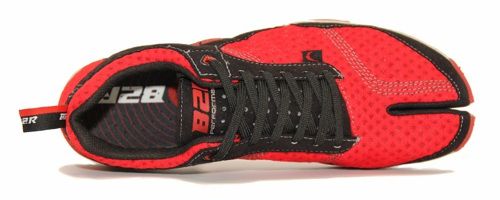
Sandals
Next to bare feet, sandals allow for the the ultimate in unhindered toe splay. The design that best enables this is the one where the sandal strap comes down between the big toe and the second toe.
The downsides to sandals are that:
- Your feet and toes have no protection from the top.
- The strap between the toes can give you a toe-wedgie on the downhills, as that is all that is keeping your foot from sliding forwards.
Tabi shoes are kind of like sandals with a top cover and laces. You still have something between your toes to hold your foot securely in place, and your toes can also still splay out because of the split design. You also get additional security over sandals from the uppers and laces holding your foot in place.
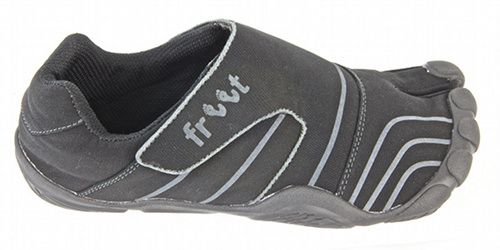
Toe Shoes
Vibram FiveFingers take a different approach to the toebox problem. By giving each toe it's own pocket, you have good toe splay and better security than a sandal because of the glove-like fit.
The downsides to toe shoes are:
- The generic toe pocket design doesn't always suit everyone. Some people have toes that are too fat to easily fit into the pockets. Others have a second toe that is too long for the toe pocket, etc.
- The glove-like design has limited usefulness in cold conditions.
Tabi shoes are kind of like toe shoes, except with only two pockets instead of five. It allows for a little more variability in toe size/shape since each toe does not have to fit into it's own pocket. Tabi shoes will also work a bit better in cold conditions because more of your toes are kept together for warmth.
Standard Closed Toe Shoes
Most barefoot/minimalist shoe designs have attempted to improve toe splay by using a more natural or anatomic last. This basically means that they have widened the toebox to some degree.
The downsides to closed toe shoes are:
- Maximum toe splay is limited by the width of the last and the stretchiness of the fabric.
- The wider the toebox, the more difficult it becomes to achieve a secure fit. Hiking/walking/running downhill can cause your foot to slide forward and jam into the front of the shoe.
Tabi shoes are kind of like standard closed toe shoes, except toe splay is not limited by the width of the toebox. Additionally, the extra fabric between the toes provides better security, making it so that your foot moves around less inside the shoe.
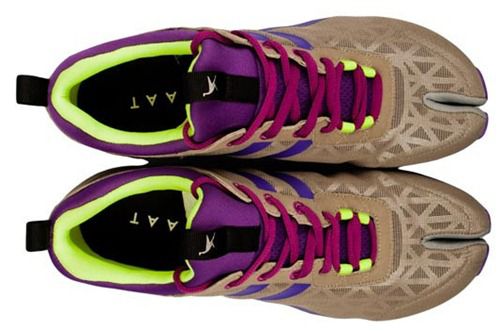
Are There Negatives?
I am a huge fan of the theory behind the split-toe design. That doesn't mean their aren't downsides though.
- You can't wear standard socks in them. You have to use either tabi or toe socks. That is OK with me because I love toe socks and wear them all the time no matter what shoes I am wearing. I have heard though that some people have a problem with this.
- Stuff will get caught in the toe crack. Grass, rocks, etc. Toe Salad was named after the vegetation that collects between the toes of Vibram FiveFingers when walking or running through tall grass. Tabi shoes share this phenomenon, albeit not to the same degree.
- Some people think it looks funny. The first comment I got from my father-in-law when he saw a pair on my feet was that it looked like cloven hooves. I think the tabi design looks pretty cool, so again (like the sock issue) this downside is subjective.
I honestly can't think of any other negatives at this point. Based on the theory, the design looks pretty good right? There are of course a whole host of other negatives that could occur, but those are dependent on the implementation. As they say, the devil is in the details. Let's hope that shoe companies are able to pull-off this design without messing-up the benefits or creating new problems.
So, now that you have heard my stance on the tabi design, what do you think? Is this the evolution of minimalist footwear, or just another markting gimmick? Tell us your thoughts in the comments.
